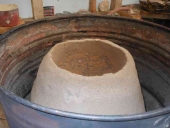Hi Erica,
Thanks for the response.
I made a mix of clay, sand, cement and vermiculite for the base.
Then I built the rocket portion with firebrick on top of that base, so it is well-insulated from the cement floor.
Then I used bricks to form the ring for the barrel and the outer wall to contain the runs of exhaust pipe.
The exhaust pipe comes back behind the barrel and then goes up to the ceiling, then it follows the ceiling to almost the peak, and then penetrates the ceiling.
I used a sand, clay and cement mix to create my mass around the firebox and encase the exhaust pipe until it went vertical. There is a clean-out right after the ring for the barrel, at the start of the exhaust run, and another at the bend in the exhaust run.
The pictures don't show it, but I built a wall of bricks up to the level of the window, where you see cement board in the pictures. There is also more mass (several inches) on top of the exhaust run.
The rocket ran fine last winter. I saw barrel temps over 600 degrees, consistently. I put one heat-activated fan on top the barrel. A second one blowing in a different direction would probably be a good idea. I only ran the heater for a couple hours at a time (after work).
I just ran it again, last week, twice. The first time, it ran fine. The second time, it actually burned backward. I had a fire coming out of the feedbox. I put a couple wads of newspaper in the first cleanout and set it on fire, to create a draft through the barrel and it kinda worked to pull the flame back into the burn channel, but then the flow reversed and the fire came back out of the feedbox. So that was kinda weird. We've had a really weird winter so far (up to 50 degrees), and I've been busy with other stuff, so I haven't tried to run it again. After the second burn I opened the barrel from the top and everything looked fine. I did vacuum out the feedbox and burn channel.









